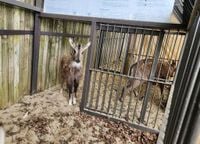On June 10, 2025, Seoul Grand Park took a significant step in its ongoing commitment to conserving endangered wildlife by exchanging several long-tailed gorals (Naemorhedus caudatus) with the National Institute of Ecology's Endangered Species Restoration Center. This carefully coordinated effort involved transferring three young female gorals, bred at the zoo in 2023 and 2024, to the restoration center, while importing one male goral back to the zoo. The move aims to enhance genetic diversity within the captive population and strengthen the broader conservation strategy for this vulnerable species.
The long-tailed goral, designated as a Class I Endangered Wild Animal and a Natural Monument by South Korea's Ministry of Environment, is listed as Vulnerable on the International Union for Conservation of Nature (IUCN) Red List and protected under Appendix I of the Convention on International Trade in Endangered Species of Wild Fauna and Flora (CITES). This classification strictly prohibits international trade, reflecting the species’ precarious status worldwide.
In South Korea, these agile mountain dwellers primarily inhabit the northeastern regions of Gangwon Province, including Mt. Seorak, and the Baekdudaegan mountain range. Recognizing the goral’s vulnerability, the Ministry of Environment and the Cultural Heritage Administration have been actively collaborating on conservation projects to secure the species’ future.
Seoul Grand Park's role as an ex-situ conservation institution has been pivotal in supporting these efforts. In late November 2022, the zoo formalized a partnership with the National Institute of Ecology's Endangered Species Restoration Center through a business agreement focused on joint research and cooperation regarding endangered wild animals. Shortly afterward, in early December 2022, the zoo imported a male goral to complement its three resident females, which was a critical step given the limited genetic pool available at the time.
Since then, Seoul Grand Park has successfully bred five gorals—two in 2023 and three in 2024—by creating a carefully managed and suitable breeding environment. This success has increased the zoo’s total goral population to nine individuals, including one male, three females, and five offspring. The newly imported male goral, bred at the restoration center, is expected to alleviate the genetic bottleneck that had threatened the population’s viability.
The three female pups transferred to the National Institute of Ecology's Northern Conservation Center will undergo rigorous pre-release training, a vital preparation phase before their eventual reintroduction into the wild. This training includes developing survival skills and acclimating to natural conditions, ensuring a higher chance of successful reintegration into their native habitat.
Seoul Grand Park will continue its ex-situ conservation duties, focusing on breeding, advancing rearing technologies, and managing bloodlines to maintain genetic health. Meanwhile, the restoration center will oversee in-situ conservation tasks, including release training, the actual release of animals into the wild, and post-release monitoring to track their adaptation and survival.
Park Jin-soon, the director of Seoul Grand Park, emphasized the importance of this initiative, stating, "Conserving native endangered species like the goral is the direction and core strategy of Seoul Grand Park. We will persistently advance conservation projects not only for the goral but also for other endangered species such as the musk deer, golden frog, and flying squirrel, fulfilling our role as an ex-situ conservation institution."
This collaborative approach between Seoul Grand Park and the National Institute of Ecology exemplifies a comprehensive conservation model that balances captive breeding with wild population reinforcement. By exchanging individuals to enhance genetic diversity and preparing young animals for release, these institutions are working hand-in-hand to secure the goral’s survival amid ongoing environmental challenges.
As habitat loss, climate change, and human activity continue to threaten wildlife globally, efforts like these demonstrate the critical role that well-managed zoos and restoration centers play in safeguarding biodiversity. The goral’s story is a hopeful reminder that with dedicated cooperation and science-based strategies, even vulnerable species can have a fighting chance at recovery.

